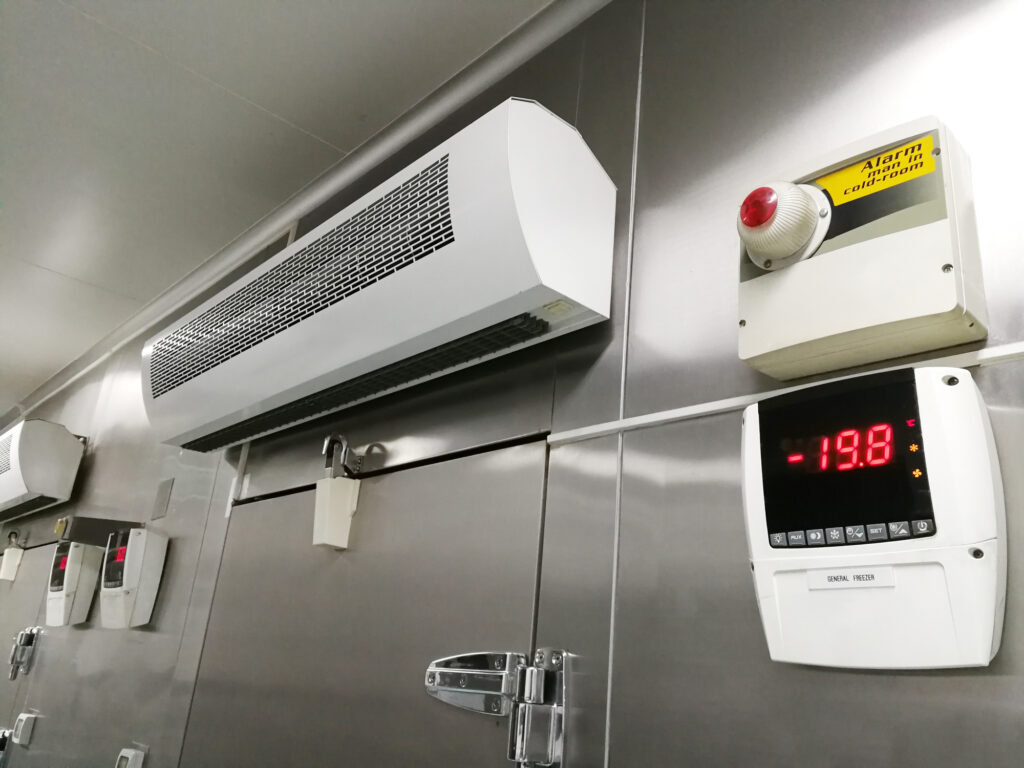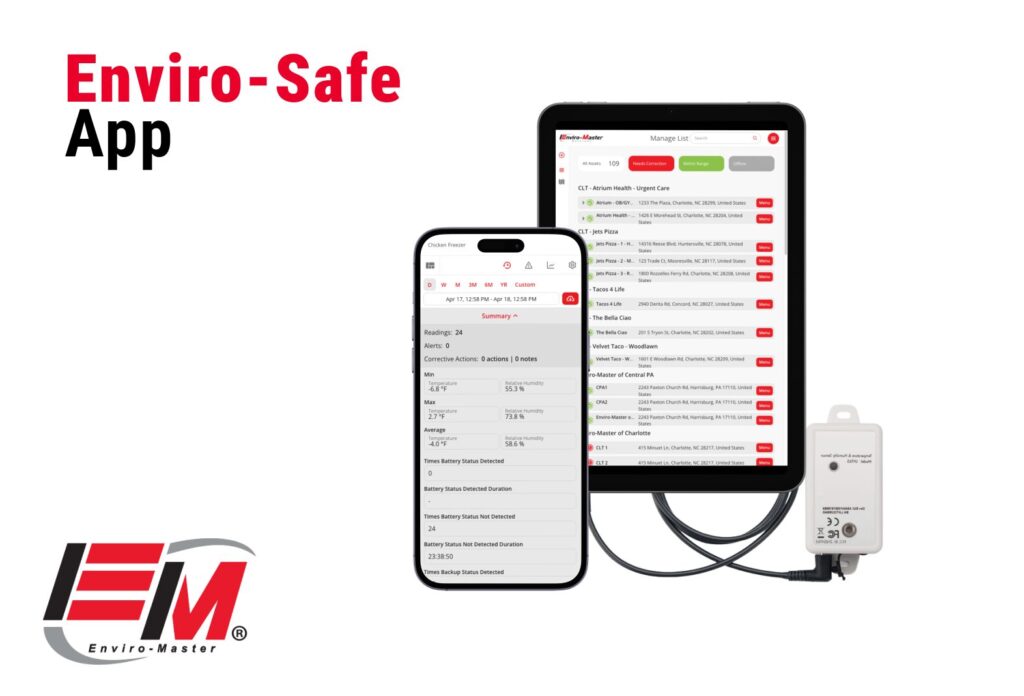To monitor freezer temperature remotely, businesses should install wireless temperature sensors inside their freezers and use a mobile app like the Enviro-Master Enviro-Safe app for real-time monitoring and instant alerts. This system allows for continuous temperature monitoring, regulatory compliance, and ensures food safety by providing instant notifications of temperature deviations, helping prevent spoilage and equipment failure.
Monitoring freezer temperatures is crucial for businesses like restaurants, hospitals, and pharmaceutical companies that rely on precise temperature control to ensure safety, compliance, and efficiency. Utilizing remote temperature monitoring systems using modern technologies and best practices can make a big difference for your business.
Importance of Remote Freezer Temperature Monitoring
Food Safety and Compliance: For restaurants and hospitals, maintaining the correct temperature in freezers ensures that food and medical supplies are stored safely, reducing the risk of spoilage and contamination. Regulatory compliance with health standards is also a critical aspect, as improper temperature control can lead to penalties and legal issues.
Equipment Health: Continuous monitoring helps in early detection of equipment failure, allowing for timely maintenance and avoiding costly repairs or replacement of refrigeration units.
Remote freezer temperature monitoring not only ensures compliance with food safety and health regulations but also enhances the longevity and efficiency of refrigeration equipment. By automating temperature control and monitoring, it minimizes the risk of spoilage and reduces the workload on staff, allowing for a more efficient use of resources and energy. This integrated approach not only safeguards against potential losses but also boosts operational productivity across the board.
Key Components of a Remote Temperature Monitoring System
- Temperature Sensor and Additional Sensors: Install wireless temperature sensors inside the freezer to measure the ambient temperature continuously. Additional sensors like humidity sensors can be integrated to monitor humidity levels, which are crucial in cold storage environments.
- Remote Temperature Sensor with Wireless Capability: Utilizing wireless sensors allows for the flexibility of placement and easy installation. These sensors should have a robust battery life to ensure continuous operation without frequent maintenance.
- Mobile App and Remote Monitoring Capability: A mobile app is essential for monitoring temperature data in real time. It should provide instant alerts and alarm notifications if the temperature deviates from the set range, allowing for immediate action.
- Bluetooth Sensor and Connected Devices: For smaller setups or additional flexibility, Bluetooth sensors can be used. These devices connect with a central system or mobile app, providing real-time data and alerts.
- Temperature Probe and Refrigeration Equipment: For precise measurements, especially in large commercial freezers, a temperature probe might be necessary. This ensures that the temperature monitoring is accurate across different parts of the freezer.
Advantages of Remote Temperature Monitoring
- Instant Alerts and False Alarm Reduction: Modern systems can differentiate between temporary fluctuations and real temperature issues, reducing false alarms and focusing on significant alerts.
- Regulatory Compliance: Automated logs and reports help in maintaining records for health inspections and compliance audits, simplifying the regulatory compliance process.
- Continuous and Real-Time Monitoring: Provides a live view of temperature trends and ambient conditions inside the freezer, enabling proactive management of the refrigeration unit.
Remote temperature monitoring systems offer a comprehensive solution that streamlines freezer management while enhancing reliability. The ability to receive instant alerts and minimize false alarms ensures that only critical issues are addressed, improving the efficiency of maintenance responses. Additionally, automated documentation aids in effortless compliance with health regulations, while continuous and real-time monitoring allows for better control over freezer conditions, ensuring optimal operation and preventing product loss or spoilage. This approach at freezer monitoring not only secures perishable goods but also supports a streamlined safety and compliance.
Implementing a Remote Monitoring System
- Choose the Right Sensors: Select sensors that match your specific needs—consider factors like range, accuracy, battery life, and the ability to integrate with existing systems.
- Installation: Place sensors in strategic locations within the freezer to ensure accurate and comprehensive coverage. Ensure that sensors are installed away from direct contact with food or sensitive materials to prevent contamination.
- Set Up Notifications: Configure mobile app or system notifications to receive instant alerts about temperature deviations, power outages, or other critical events.
- Monitor and Adjust: Regularly check the data collected by the sensors. Analyze temperature trends and make adjustments to freezer settings as needed.
Understanding Regulatory Requirements for Freezer Temperature Monitoring
Compliance with Health and Safety Regulations: It’s vital for businesses, especially in the food and health sectors, to understand and comply with local, state, and federal regulations regarding freezer temperatures. This section of the system ensures that all temperature data is recorded and stored in compliance with these regulations, which can be crucial during inspections.
Documentation and Audit Trails: The systems allow you to log all temperature readings and incidents of temperature deviations. This not only helps in real-time monitoring but also provides a reliable audit trail that can be invaluable during health inspections or in case of compliance reviews.
Cost-Effectiveness of Remote Temperature Monitoring
Reduction in Waste: By maintaining optimal freezer temperatures and reducing the incidence of temperature-related spoilage, businesses can significantly cut down on waste, thereby saving on replacement costs.
Energy Efficiency: Efficient monitoring can also lead to better energy management. By understanding and analyzing temperature trends and usage patterns, businesses can optimize their energy use, potentially lowering electricity bills.
Choosing the Right Remote Temperature Monitoring System
Customization and Scalability: Different businesses have different needs based on the size of their operations and the specific items they store. A system that offers customization and can scale with your business growth is ideal.
Integration with Existing Systems: For businesses that already have some form of digital infrastructure, choosing a monitoring solution that can seamlessly integrate with existing systems will provide a more streamlined approach and reduce the complexity of managing multiple interfaces.
Enviro-Master’s Enviro-Safe App
Remote freezer temperature monitoring is an essential component for businesses requiring stringent temperature control. Utilizing the Enviro-Master Enviro-Safe app, along with wireless temperature sensors and advanced temperature probes, businesses can significantly enhance food safety, adhere to regulatory standards, and avoid equipment failure. By deploying a robust remote temperature monitoring system, companies not only protect their valuable products but also boost operational efficiency, ensuring a seamless integration of technology and compliance in their daily operations.





